Chess Set
COLOURFUL CAMPO COMBINATIONS
Abbreviations:
MMP (the MacMillan Project)
RRP (the Rob Roy Project)
PdA (Piezas de Ajedrez, an Argentinian Youtube channel)
FADA (Argentinian Ajedrez Federation)
FFS (let’s get a move on)
I absolutely adore working week in and week out with different chess sets from different parts of the world and consider myself very fortunate in being able to do so. Many of these sets draw you in, like a Sisley or a Dali, or a rough pencil sketch by Leonardo. The more you focus on what is before you the more intriguing and beautiful they appear, much like giving your undivided attention to a classic game of the past for a few hours – you come away enriched and inspired – full of piss and vinegar.
This was the case just recently. A set landed on my doorstep from the well-known U.S. collector Robert MacMillan, who had had in his possession for some time an “Argentine Olympic” set in “so-so condition” that was in need of some TLC, and he graciously allowed me free rein on a well-needed artistic restoration – which is always nice. Once opened, the pieces with their gigantic collars and plainly cut knights looked familiar, but I couldn’t quite remember where I’d seen them before, a case of ‘in one eye and out the other,’ as they say over in Ireland. But more on that later, because if you’re in any way artistically inclined and partial to a dip into chess history, you may well appreciate the next two Chessays, as they provide an insight into the various steps and finishing techniques I employ to cast back into circulation not one of these classic Argentinian designs, but TWO! How lucky are YOU, dearest reader!!
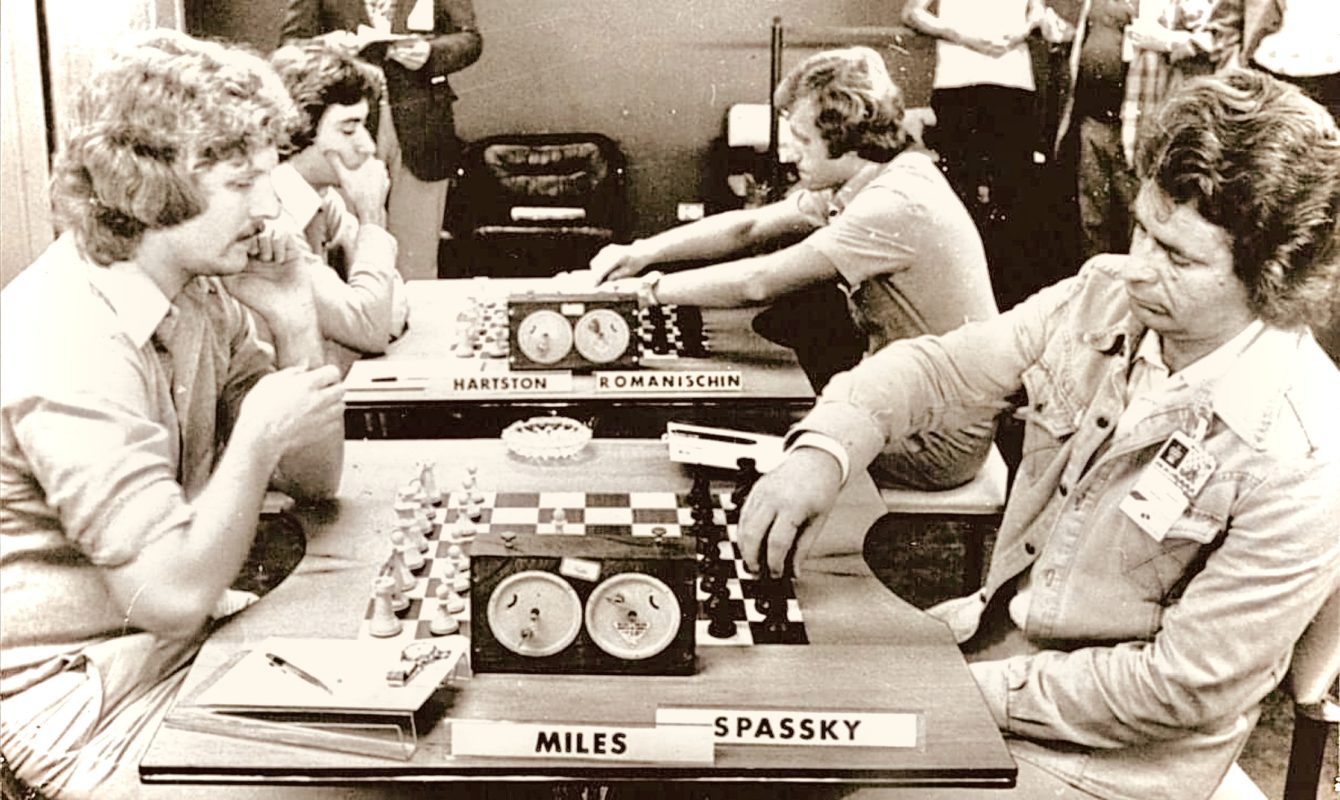
But before we delve into all the arty-farty malarkey (which we’ll concentrate on in our April Chessay), let’s quickly familiarize ourselves with the Argentine pattern at hand. Collectors officially refer to them as Argentinian 1978 Olympiad Chess Sets, or in South America, Modelo Olimpico Campo (a reference to the company that produced them), which we see here in action (PIC 1, above) during the 23rd Chess Olympiad held at the famous River Plate Stadium, Buenos Aires in 1978, plus a few additional up-close-and-personal shots of the official ‘matte’ tournament set (PICS 2&3, below) courtesy of the all-encompassing Chuck Grau Collection, a name that should need no introduction.


The very first English grandmaster on the left is the wit that was Tony Miles (1955-2001). Buenos Aires at this time was a city caught in a heatwave and under military rule. Writing in his New Statesman chess column, Tony had this to say of his temper-testing time in BA:
“We arrived to learn that the chief organizer had just been ‘kidnapped’. It later transpired that this was the one and only sensible thing he had arranged during the whole tournament. The choice of venue was inspired. The playing hall was a badly ventilated corridor inside the River Plate football stadium (matches once clashed!). The stadium also happened to be near the airport, on the main flight path, and immediately opposite a shooting club (matches often clashed!).”
Incidentally, I believe the first photo shows the Miles/Spassky opening moves of game 45 in Tony Miles: It’s Only Me (Batsford Books, 2003, p.103) with Spassky just deciding on the reply Nf6 to Tony’s 1. d4, heading for a Queen’s Indian Defence. Note that Miles has his wristwatch placed coyly over his score sheet, a quirk of the Englishman, as he famously recorded all his moves in Cyrillic!
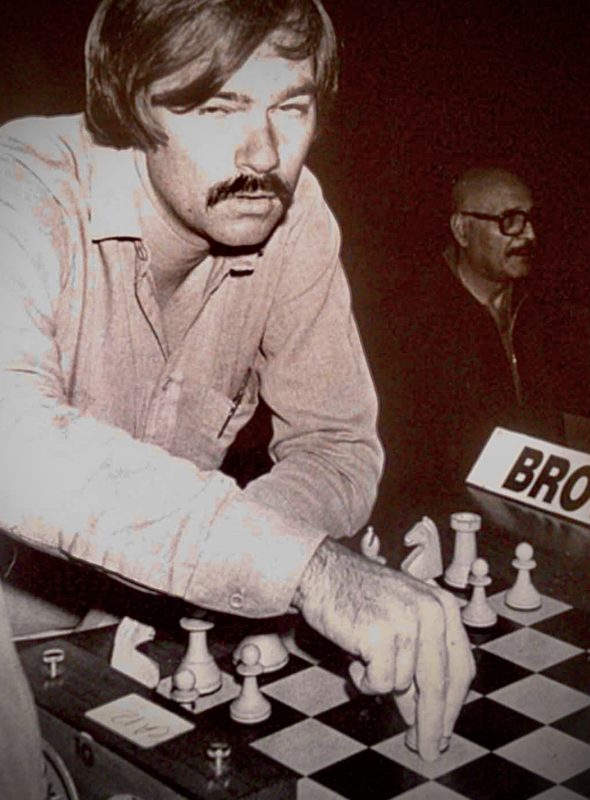
Most probably from the same tournament, we have another insightful photograph of the Aussie/American, Wally Browne, clearly showing the angled ridge above the eye of the knight and a hint of a mane (PIC 4, left). By Wally’s tempestuous expression, it looks like the snap was perhaps taken during an uproarious Club Atletico River Plate football match in the stadium above, shooting drills, a fly-past, or perhaps after a heavy night of ‘analyzing’ with the lads? Or possibly all of the above! Those 70’s tournament grifters, man. Crazy dudes!!
But cavorting back to our narrative, let’s pick up on what arrived on the doorstep. Basically, a knocked about Campo ‘club’ set very similar to the official Olympiads that were commissioned by FADA specifically for the 1978 tournament.
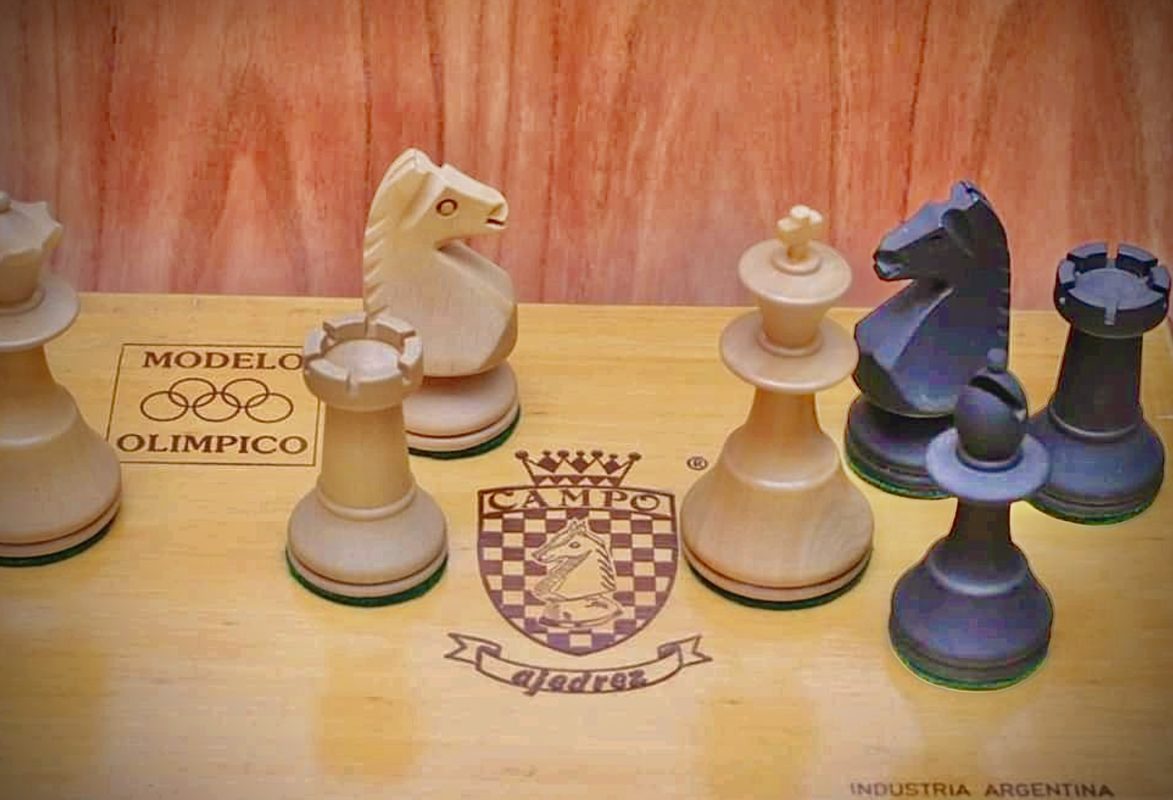
These Olympiad sets, we know from our South American friends, were afterwards distributed amongst the various regional chess clubs for use in local and national competitions, gifted for the most part to the oldest and largest one, Club Argentino de Ajedrez (1905-present) in Buenos Aires. Opinions differ, but close to 200 sets were custom-made for the Olympiad, manufactured by the renowned Argentine wood-spinners, Casa de Los Hermanos Campo (PIC 5, right).
These now highly collectable sets were then either put to good use in tournaments, used as prizes for competitions or sold on by club officials to club members and collectors, enabling them to purchase newer clocks and equipment or to simply pay rent – and of course, many of them just went AWOL as their value gradually increased. That said, you can still occasionally find these originals on the market today, usually for around $1500.00 U.S. At the time of writing there is one available on our facebook page THE CHESS EXCHANGE via the reputable Argentinian collector/seller, Nahuel Crusta, where more details/photos can also be found regarding the tournament itself. (PICs 6&7, below)


The company Casa de Campo produced several different versions of the Olympiad pattern, before, during and after the 1978 tournament until it closed its doors in 1988. ‘The MacMillan Project’ (that sounds like a spy flick!), I believe, is a slightly earlier mixed ‘club’ set (only the white queen carries lead weight) with some unsightly flaking issues on the dark side and some crude hand-painted pieces on the light (PIC 8, below), which are like warning flares to me – DANGER BELOW!
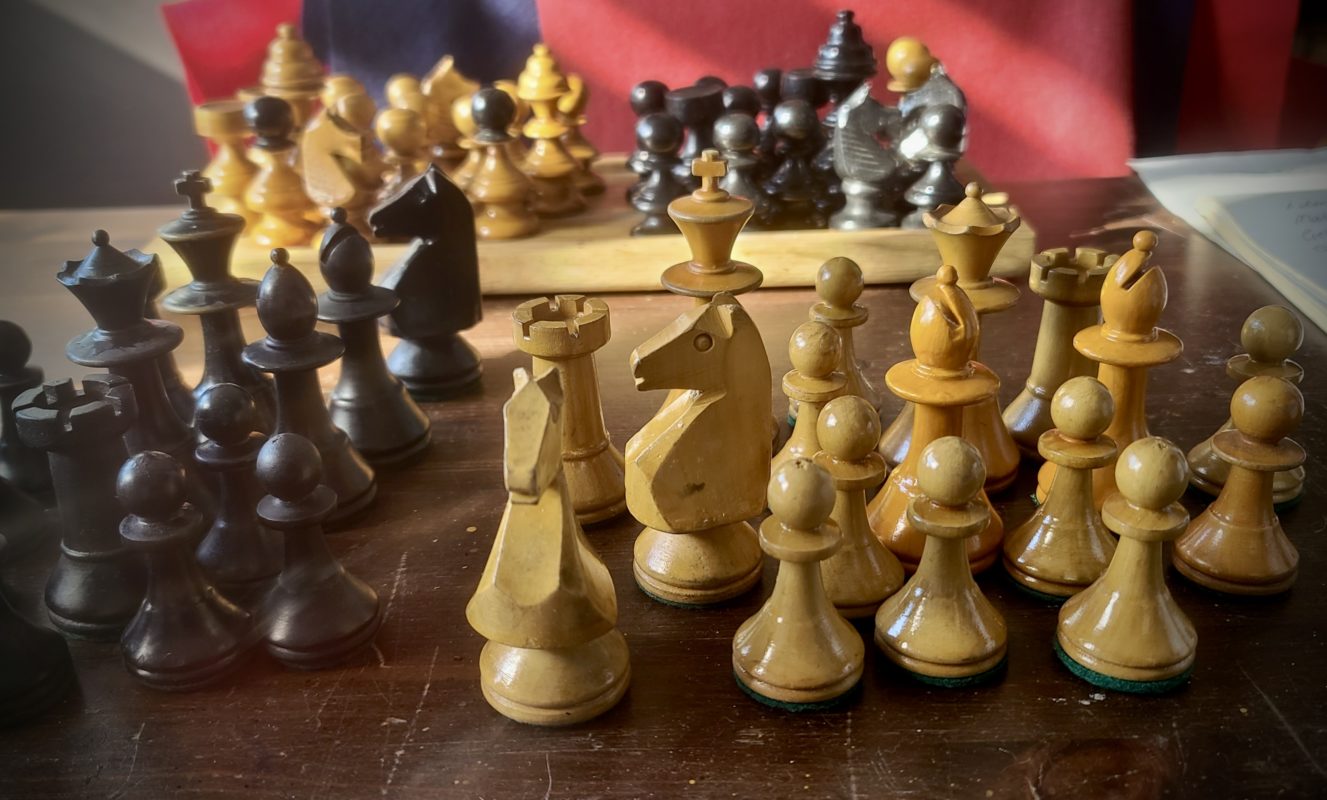
Most of these Olympiad style sets were produced from 1972 on, when FADA commissioned their first sets from the Campo brothers coinciding with the spread of ‘Chess-Fever’ that hit the planet like Covid during the build-up to the Fischer-Spassky World Championship clash in the early ‘70s. The knights are a simpler version of the more detailed Olympiad, the brow is cut in a similar fashion but at an acute angle (like the later Olimpico ‘King’ sets) rather than grooved and the snazzy manes that first appear on a “pre-Olympic” (PdA) lacquered Campo set, c.1976-77 (PICs 9&10, below) are yet to be seen. Note here the four crenellations of the rook (rather than six) and the thinner mitre cut on the bishop.


These MMP simplifications are evolutionary and hark back to “el primero juego” or ‘the first’ Campo set that soon fell out of favour with Argentinian club players as they had a tendency to wobble and topple over in rapid play, pictured here (PIC 11, below left) with El Rey Primero on the left (King Height 9.6cm, base width 3.5cm). And just to consolidate this ‘wobbling’ problem with the first Campo tournament patterns, here is what Senor Juan Marcelo Campo, a son of one of the original owners, had to say on the matter in a 2018 conversation with the PdA, another Argentine authority on the Campo patterns:


“The first set (‘primero juego’) that ‘los hermanos Campo’ released came in a red cardboard box with the word AJEDREZ written in black over a yellow background. (PIC 12, above right) The pieces were lacquered (‘brilantes’) and due to the low base diameter/height ratio these pieces tilted and fell quite easily. This is the [first] set that used lead weights.” [my translation]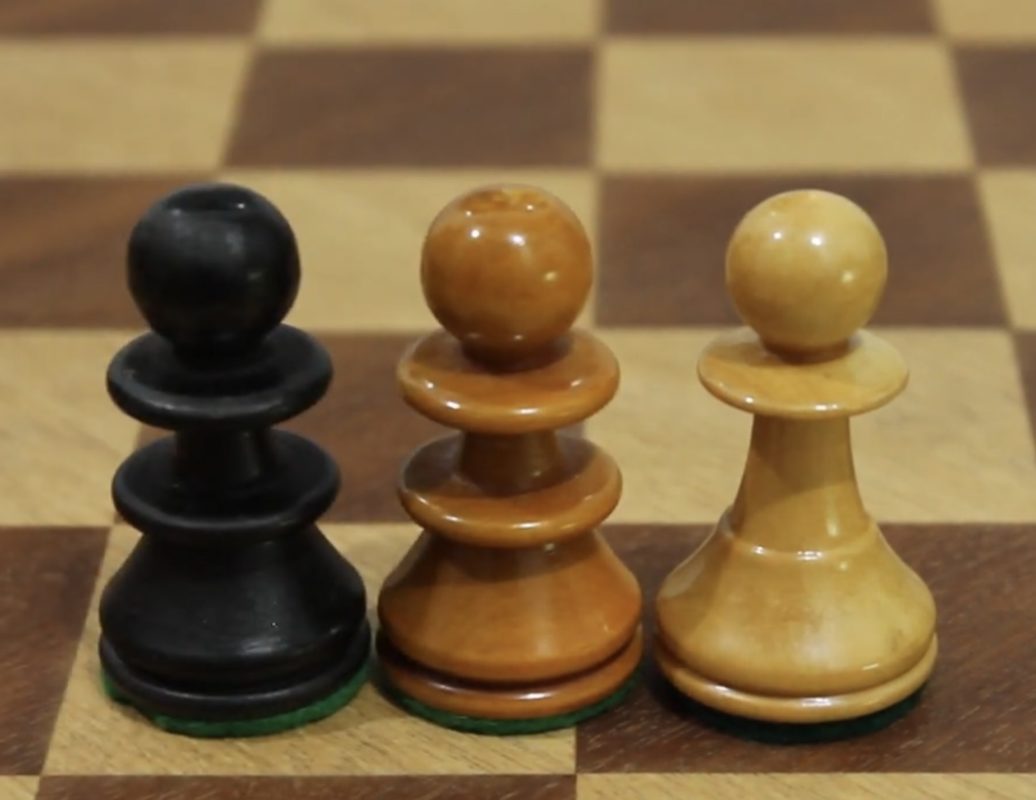
Personally, being a slow mover, I’m a great fan of these “Olimpico Predecessors” (PdA) with their distinctive ‘double-collared’ pawns (PIC 13, above) that smack of some pre-Staunton Victorian sets of the past. Chatting with the convivial Argentine collector, Jonaton Sciuto, he roughly dates this set to the “early 70’s” around the same time they began manufacturing club sets for FADA in 1972. Here we see the Campo knights (left and right) in their most rudimentary form (PIC 14, below left). The mane is superfluous, the brow is ignored and the broad, bullish head (PIC 15, below right) tapers gently down towards a simply cut, under-exaggerated mouth. Simplistic South American chess artistry at its finest.


This brings us nicely onto the second Campo project, the RRP (PIC 16, below), named in honour of the amiable Australian collector, Rob Rankin, who very generously passed on this and several other ‘needy’ sets that will re-emerge back into the chess community sometime in the near future – and here, by the way, is exactly where I’d come across this Argy set before! When Rob sent them over last year I wasn’t too familiar with the design at all, to be honest, so I marked them down as “Spanish/S.A??” thought ‘nifty mate!’ then placed them into a lengthy queue for attention. Then, halfway through the MMP my old brain cell finally pinged – this is the spitting image of the RRP set in storage!! – and BOOM! All of a sudden I had the golden opportunity of comparing and resurrecting TWO CAMPO SETS, one after the other. That old fellow Fate deals out some good cards at times!
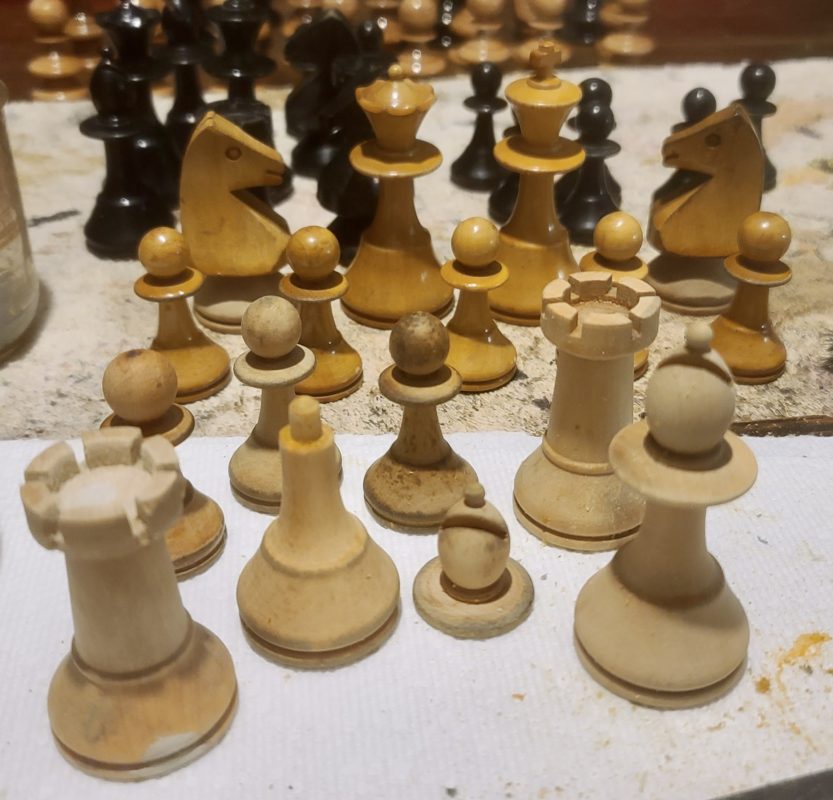
The RRP pattern closely resembles the Primero or “modelo 1er” (PdA), but has an updated diameter/height ratio, being shorter and un-weighted with wider bases (King 9cm tall with a 4cm base width and Olympico cruz finial) and like the MMP, I believe this to be a lacquered, mixed ‘club’ set, pre-tournament (c.1972-77) with early knights (PIC 17, below left) and a few replacement pawns. Moreover, we can date this with some confidence, as according to the PdA, “after 1978 all Campo sets had a matte finish” and show various examples in their videos. Note that these knights also lack the brow cut above the eye, but the head is much thinner than the Primero knights, more in tune with the MMP and similar to the caballero logotipo on the Casa de Campo boxes but without the mane. (PIC 18, below right). The wooden comparison (pictured) is from an un-weighted set the PdA call “Campo (Light) Chess Pieces – One of the firsts from House Campo!” (King 9.8cm, 4cm base width). One of the first ‘light’ sets, which would also date them to around 1972-75, was probably a less-expensive, un-weighted FADA commission for Argentine clubs and general retail.


Perusing over just a few of these early Campo examples, however, we are privy to insightful glimmers into the gradual evolution of the Campo club pieces heading towards the 1978 Olympiad pattern, which was more stable, a tad more Stauntonesque, and more elaborately detailed. Hopefully, this will generate greater interest in these sets and any further information or corrections will be added to this Chessay in the future.
That said and now that we are fairly familiar with this Argentinian pattern I’m going to take a little break and finish off the RRP, which is in need of a few final touches (i.e. I need to get back to my arty-farty malarkey!!). April’s Chessay will follow in May. 😉 Keep ‘em peeled!
Until next June – Check you later!
PIC 1-4 from Argentina 1978 Olympic Chess Pieces, chess.com forum,
July 25, 2016, informaticacobach29 (Manuel Rodriguez)
PIC 5 still from PdA youtube video
PIC 6&7 photo Nahuel Crusta, Cordoba, Argentina.
nahuelcrusta@gmail.com
PIC8 author
PIC9 from PdA youtube videos
PIC10 Chuck Grau Collection and photograph
PIC11-15 stills from PdA youtube videos
PIC16, 17 author
PIC18 from PdA youtube video
Juan Marcelo Campo quote from “The First Campo Chess Set. Olympico Predecessor.” from PdA youtube video. Just google ‘Piezas de Ajedrez’ and find them all! As a heads up, if you’re not fluent in Spanish, Youtube has a handy function that shows subtitles (where available). Simply hit the subtitles button, then screenshot and translate by app or Google Translate. If you’re “fair to middling” with Spanish you can slow down the commentary by hitting the button just above. Thank me later, caimans!!
All rights reserved: Alan W. Power (The Chess Schach), March 2022

I enjoyed reading this article. I grew up in Buenos Aires and started to play chess a year or two after the 1978 Chess Olympiad. I played in the club Torre Blanca (white rook), and we had plenty of those “olímpico” sets. I always loved them, both for their simple and elegant design, the matte finish, and the weight so well distributed that the pieces could endure chaotic blitzing without (or rarely) falling. I believe the Campo olímpico chess set became the favorite of some GMs, and I believe it was used in the 1980 Korchnoi-Polugaievsky candidates match in Buenos Aires. I just tried to find an image online to corroborate this but could not. This poor-quality video on YouTube looks vertically elongated, distorting the pieces we can barely spot, at 1:05 or so: https://www.youtube.com/watch?v=SbU_SIVFWWc.
In the mid-1990s I came to the USA for grad school and ended up settling down here. In a trip to Buenos Aires, probably around 2000, I bought a chess olímpico-King set from Juan Sebastián Morgado’s shop. I still have it, and in fairly pristine condition. I may have simply never used it for a game. Only for some analysis at home. I want to say that I paid 200 USD at the time, but I am not fully sure. The pieces, as you know, occupy a slightly larger area than the pieces of most other sets, and I always found that if the board does not match this (if the squares are not very slightly larger than they typically are) the magic evaporates. On many a regular board, these pieces will look crowded.
I’ll be happy to send you some photos of the set I own if you email me back.